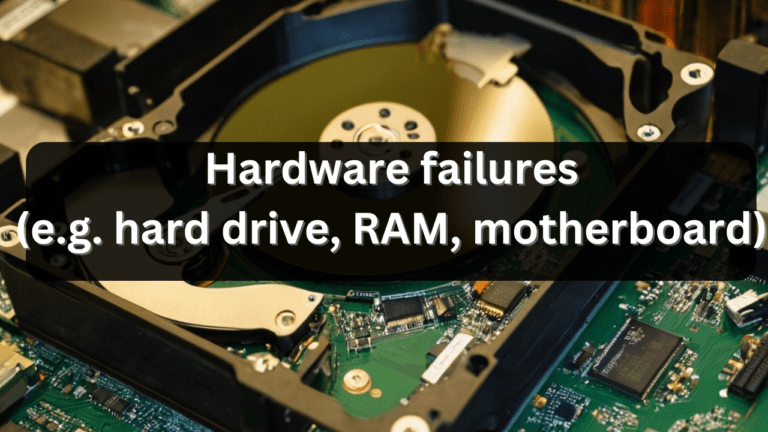Hardware failures (e.g. hard drive, RAM, motherboard)

Hardware failures refer to the malfunctioning or breakdown of physical components within a computer system. These failures can disrupt normal operations, leading to data loss, system crashes, and overall reduced performance. Some common hardware failures include issues with the hard drive, RAM, and motherboard. As a desktop support engineer, you can follow these steps to troubleshoot hardware failures on a desktop computer:
Table of Contents
Hard Drive Failures:
- Symptoms: Clicking or grinding noises, frequent error messages, slow file access, and system crashes.
- Causes: Mechanical failure, bad sectors, overheating, power surges, or manufacturing defects.
- Impact: Potential data loss compromised system stability, and a significant decrease in overall system performance.
RAM Failures:
- Symptoms: Frequent system crashes, blue screen errors, random restarts, and application errors.
- Causes: Overheating, electrical issues, manufacturing defects, or simply aging.
- Impact: Degraded system stability reduced multitasking capabilities, and overall sluggish performance.
Motherboard Failures:
- Symptoms: Inconsistent power supply, failure to boot, random shutdowns, and peripheral devices not working.
- Causes: Overheating, power surges, defective components, or physical damage.
- Impact: Complete system failure, loss of connectivity, and potential damage to other connected hardware components.
Troubleshoot this Issue
- Check the hardware component: If you suspect that a hardware component, such as a hard drive, RAM, or motherboard, is failing, physically inspect the component for any obvious signs of damage or wear.
- Run hardware diagnostics: Most computer manufacturers provide hardware diagnostic tools that can help you determine if a hardware component is failing. Run these diagnostics to get a more detailed understanding of the issue.
- Check for malware: Run a full system scan using a reputable antivirus software to ensure that the hardware failure is not due to a malware or virus infection.
- Update the BIOS: Make sure that the BIOS is up to date. You can check for updated versions on the computer manufacturer’s website.
- Replace the hardware component: If the hardware diagnostics indicate that a hardware component is failing, you may need to replace the component. Make sure to follow the manufacturer’s instructions and use only compatible components.
- Contact the manufacturer: If the above steps do not resolve the hardware failure, consider contacting the computer manufacturer for assistance.
Prevention and Mitigation:
- Regular system maintenance, including cleaning and proper ventilation, can help prevent overheating issues.
- Use a reliable power supply and invest in surge protectors to safeguard against electrical issues.
- Regularly back up important data to minimize the impact of potential hard drive failures.
- Conduct hardware diagnostics and monitoring to identify potential issues before they escalate.
- Timely replacement of aging components can help prevent unexpected failures.
Dealing with hardware failures often involves troubleshooting, identifying the faulty component, and either repairing or replacing it. It’s crucial to have backups of important data and a proactive approach to hardware maintenance to minimize the impact of potential failures on system performance and data integrity.
It’s important to regularly backup important data to protect against data loss from hardware failures. Additionally, keep computer components clean and free of dust to prevent overheating, which can lead to hardware failures.
Troubleshoot Other problems
- Boost PC performance
- Operating system errors
- Virus and malware infections
- Blue screen of death (BSOD)
- Network connectivity issues
- Printer issues
- Email and communication problems
- Power and battery issues
- Display and video problems
- Sound and audio issues
- Driver issues
- File and data corruption
- Application errors and crashes
- Operating system updates and patches
- Backup and restore issues
- Password reset and recovery
- User profile issues
- Permission and security problems
- Mobile device integration issues.
